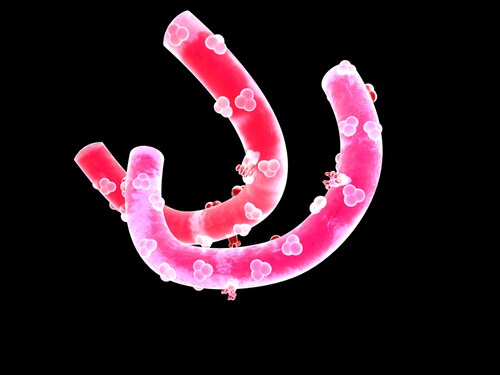 Once the Ebola virus (EBOV) gains entry and infects a host cell, a cascade of virally induced events switches the host to production of virus particles, thus propagating the infective process. Although much is known about the pathways involved, some missing steps still need to be uncovered. For this reason, Leung et al. (2015) used EBOV viral protein constructs to examine host and virus interactions that contribute to infection, focusing on protein associations that are essential steps in this process.1
Once the Ebola virus (EBOV) gains entry and infects a host cell, a cascade of virally induced events switches the host to production of virus particles, thus propagating the infective process. Although much is known about the pathways involved, some missing steps still need to be uncovered. For this reason, Leung et al. (2015) used EBOV viral protein constructs to examine host and virus interactions that contribute to infection, focusing on protein associations that are essential steps in this process.1
When EBOV infects a cell, viral RNA transcription begins so that protein synthesis can take place. Viral mRNA synthesis only occurs, however, when the viral-dependent RNA polymerase RDRP complex forms. This complex comprises an enzymatic component, large protein L, nucleoprotein (NP), and viral proteins 35 (VP35) and 30 (VP30). During the RNA synthesis process, NP plays a role in covering and uncovering binding sites on the emerging RNA templates; however, previous studies have shown that VP35 function impacts the NP aggregates to control EBOV RNA synthesis.
Leung and co-workers generated truncated constructs of both NP and VP35 based on previous studies and then tested their binding abilities separately using minigenome assays. Using this technique, the team found the key locations important for binding ability in each viral protein construct. For example, the assays revealed the first 24 residues of NP as essential in viral replication and onward infectivity through association with the RDRP complex. C-terminal deletions significantly reduced activity to 10% of that seen in wild-type constructs.
In other assays, the researchers located an essential NP-binding protein region (NPBP) within VP35, narrowing down the critical regions through various functional assays. Leung et al. further characterized the binding site association by examining conformation, stoichiometry and secondary structures under various conditions.
From these results, the researchers then demonstrated competitive binding to NP between ssRNA constructs and the NPBP, suggesting that the role of VP35 might be to regulate NP in a form accessible for RNA binding. They further examined this association, showing that the NPBP on its own (as a separate construct from the rest of VP35) inhibits the conformational changes in NP required for viral RNA replication. Adding NPBP into minigenome assays did not restore mutant-truncated VP35 activity in addition to inhibiting EBOV RDRP activity. This ultimately reduced or abolished EBOV replication in a HeLa cell reporter assay.
From this work, Leung et al. have now identified and characterized key regions within NP and VP35 that are essential to EBOV viral replication. They conclude that the targets identified represent potential areas for therapeutic development of antivirals effective against filovirus infection.
Reference
1. Leung, D.W., et al. (2015, April) “An intrinsically disordered peptide from Ebola virus VP35 controls viral RNA synthesis by modulating nucleoprotein-RNA interactions,” Cell Reports, 11 (pp. 376–89), doi: 10.1016/j.celrep.2015.03.034.
Post Author: Amanda Maxwell. Mixed media artist; blogger and social media communicator; clinical scientist and writer.
A digital space explorer, engaging readers by translating complex theories and subjects creatively into everyday language.
Leave a Reply